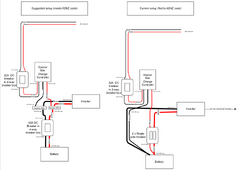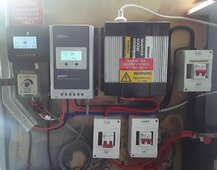12VoltInstalls
life passes by too quickly to not live in freedom
FWIW I do a ‘stationary’ RV. Saved me enough over a few years to buy a small piece of property.caravan a oldy style classic 1978 and has aluminum can grade roof,when its hot, it's hot,when cold it's cold,next to no insulation
I’m ‘stationary’ so I have a tiny yet substantial solar power system completely offgrid. I change stuff around for fun but need to finish employing all my solar. Currently just getting by on around 2kW of panels but the 2000W inverter is ample. Just pulled wire through my underground conduit today and hope to have another 1000W of panels online in the next week or so.
My RV is a 1976-ish Dutch Craft 25 that was built with a 4-season option, insulated floors, etc. so not “terrible” to heat. But I remodeled over time and added a lot of additional insulation- 1-1/2” foam to the ceilings, 1-1/2” to the walls, interior plexiglass ‘storm’ panels instead of window screens for winter. It’s comfortable and not expensive to heat.
But anyways, 1/4” plywood is ‘moderately priced’ and paints nicely. You can insulate yourself and improve your comfort and drop heating expenses tremendously, and use the plywood over that to create a clean, bright interior.
While 1.5” of foam doesn’t sound like much, the improvements cut my heating gallons by 1/3 last year, and this past summer’s work appears to be a substantial improvement as well but it’s hard to say how much at this point.
I’m in Vermont. Winters are cold, my living space is warm.classic 1978 and has aluminum can grade roof,when its hot, it's hot,when cold it's cold,next to no insulation
Do a little at a time: at the prices of propane these days the winter fuel cost savings will be enough in just one season to be noticeable and “pay you back.” And my drains don’t even freeze anymore. 1976’s “4-season” camper was nothing like the insulation of a 2024 home, and now it is. I actually procured and need to install an air-to-air exchanger because it’s so ‘tight’ now- humidity is high and if I cook in the oven over 50-60 minutes the CO detector goes off this winter.
Just some encouragement but mostly food for thoughts.





